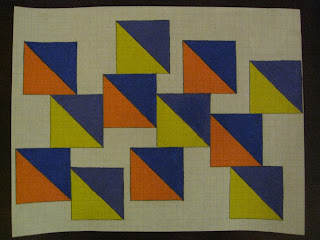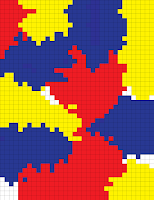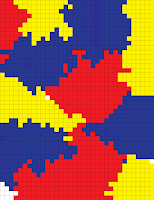"What is important is to spread confusion, not to eliminate it. Take me, I am the drug. Take me, I am the hallucinogenic." -S. Dali
When working on an art piece, I always refer to this quote. I find my work to be concentrated upon false memories, etc. Therefore, this project was exceptionally hard for me.
In viewing Sol Lewitt's artwork, I found most of his work to be fairly dry and not very visually engaging. His art pieces all required taking a step back for a holistic view, instead of concentrating upon individual parts. However, I found his most interesting pieces to be those that involved paper folding -- and that is where I drew my inspiration.
A graph paper system does not necessarily have to be a 2-dimensional display. I wanted to give my project more of an interactive, 3-dimensional, engaging feeling. Therefore, I turned to the Japanese art of origami and created an educational system for folding paper hearts.
Before starting my project, I had to physically fold a paper heart in order to remember the appropriate steps, and to choose 10 "steps" that would be most informative to the viewer. Therefore, I did a few preliminary sketches:
From then on, I created my instructional system. I feel like my project does not need an explanation -- but the explanation is in the project. The directions should all be there on the first page, and viewers should be able to look at this system and derive from it the steps to folding a miniature paper heart out of an 8.5"x11" standard sheet of paper. The first page is the first step and visually explains the process, and remains the only 2D page of this project.

From then on, I approached the system by visually presenting the physical steps represented by the first page. As seen on the left, I numbered the "steps" so that the viewer can follow along the process as it is presented along a wall. The systematic approach is entirely based upon the instructions on the first page. This is an example of step 5 of the process, and should relate to step 5 numbered on the first page.

Here is step 9 of the process. I arbitrarily colored the borders and the creases in order to emphasize the 3-dimensional quality of the paper. Sol Lewitt has several pieces in which he randomly creates marks upon a large piece of paper. I utilized one of the techniques I saw in a collection of his art pieces to color my paper heart process.
I hope I managed to achieve what I believe is one of Sol Lewitt's main artistic effects -- the viewer must take in this system in its whole in order to grasp the full experience. In the end, I also hope I managed to bring across a visually stimulating, fun, interactive, 3D approach to this system project.






















































